Square Pies & Salmon Farms
Math can explain why square pies taste better than round pies and environmentalism can explain why land-based salmon farms are more sustainable.
Read more
Math can explain why square pies taste better than round pies and environmentalism can explain why land-based salmon farms are more sustainable.
Read more
Our very own Amy Rowat explains how to use science to bake a better pie, and geneticists look at the DNA of cacao beans to breed better chocolate beans.
Read more
The Science of Pie – June 1, 2014
Best Scientific Pie
Christina Cheung, Tori Schmitt, and Elliot Cheung (Team Pretty Intense Pie Enthusiasts)
Adding alcohol to a pie crust is a fairly mainstream way of obtaining a nice flaky shelter for a delicious filling within. Vodka is the go-to spirit for crusts, but other beverages have found their way into the realm of apple pies too. One team at the 2014 Scientific Bake-Off, team P.I.E. (Pretty Intense Pie Enthusiasts), was intrigued by the plethora of alcoholic options available to them for pie crusts, and chose to use their scientific prowess to determine the best choice. Two variables guided their experiment: how do carbonation and alcohol concentration affect the flakiness of a pie crust?
Team P.I.E. began by making six experimental crust doughs, each containing either water, beer, stale beer, diluted vodka, regular vodka, and Perrier. To measure flakiness, a quality difficult to quantify, they compared the average height for each baked pie dough to indicate how much the dough has risen during baking. To account for bubbles, height measurements were taken at the center and edges of the crust.
These pie researchers calculated the elastic modulus of each crust to further quantify flakiness. Elastic modulus of a substance is the ratio of the stress applied to the resulting strain. This ratio can be thought of as a measure of stiffness, or in our case, flakiness, as the flakiest crust will break the most easily.
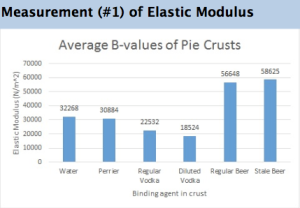
Pie crusts that utilized both forms of beer had a higher average elastic moduli than crusts with other binding agents.
They administered force to their crusts by using a pen to mimic the conditions of fork prongs stabbing a pie crust. Measured values of water balanced atop the pen acted as a weight to provide precise values of force.
Through this extensive research, P.I.E. presented data that showed that a pie crust made with Perrier sparkling water created a significantly thicker crust than one made with any of the other experimental liquids. All the other crusts surprisingly rose to very similar heights. Since P.I.E had observed similar bubble size and bubble concentration in Perrier and beer, they expected that the regular beer crust would yield similar data to the Perrier crust. However, the significant difference between the measured values of Perrier and beer imply a confounding factor in the experimental comparison. They speculate that Perrier’s high mineral content could alter the vaporization temperature of the liquid, and thus affect the creation of air bubbles and the dough’s infrastructure.
The dedication to detail and the scientific method paid off for these three scientists, as the panel of esteemed judges awarded them the title of “Best Scientific Pie”. As this was a scientific bake off, that is a pretty high honor to hold. Congratulations to the Pretty Intense Pie Enthusiasts, and we thank you for your deliciously scientific dessert!
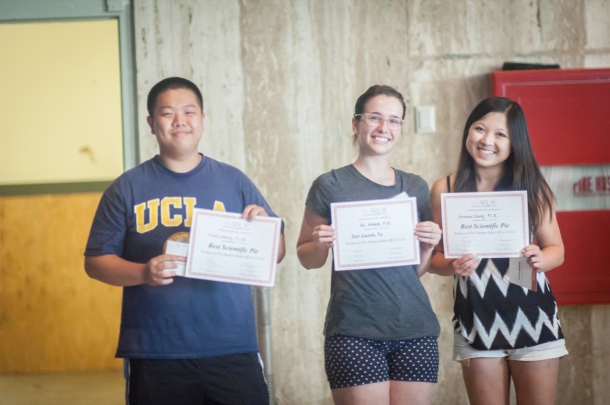
Christina Cheung, Tori Schmitt, and Elliot Cheung accept their awards for Best Scientific Pie (Photo Credits: Patrick Tran)
Recipe
Beer Crust Apple Pie
(Makes two full pies)
For crust:
Combine flour, sugar, and salt in a large bowl. (if making full recipe will require a very large bowl) Cut chilled butter into cubes and cut into flour mixture with a fork or pastry cutter. The flakes can vary in texture but absolutely no butter cubes should remain intact. The mixture will resemble corse sand. Measure out beer starting at 1/2 cup. Pour in and incorporate into dough. If dough is still dry, incorporate more beer in until the dough is just moist enough to stick together. Wrap dough in saran and refrigerate for at least 30 minutes, up to overnight.
For Filling and Assembly:
To prep the filling, core and peel all your apples and soak them in enough beer and/or hard cider to cover for 1-2 hours or until the apples are infused to taste. Pour out liquid and reserve for reduction sauce later. Be sure to remove all the liquid from the bowl and allow the apples to dry for roughly 30-45 minutes. The apples will look significantly less “wet” after the drying period. After the apples are dry, combine them with flour, sugar, lemon zest, cinnamon, and salt. Depending on the sweetness of your hard cider/beer, you may need to adjust the amount of sugar used.
Assembly:
Pre-heat home oven to 500 degrees. Section pre-chilled pie dough into four equal segments and roll out two of the pie dough segments. Place these over buttered glass pie dishes and fold into place. Split filling evenly and pour into each dish. Dot top of apples if additional butter if desired (roughly 1 TB per pie). Roll out the remaining pie crust into two top pieces. Sprinkle each top pie with an equal amount of cheese. Cheese amount will depend on strength and personal preference for cheese. Flour pin well and lightly roll/ press cheese gently into the crust (dough will be very flaky). Lay top crust evenly over pie with cheese side facing up. Crimp edges and brush with egg whites.
To bake the pie. place and oven and lower temp to 425 degrees F. Bake at this temp for 25 minutes at which point, rotate the pie and lower temp to 375 for an additional 30-35 minutes. This will produce a pie with softer apples. Alternatively the pie can be baked at 375 for a full hour, however the apples may remain more al dente. (Pie was baked in the second way for competition)
 About the author: Elsbeth Sites is pursuing her B.S. in Biology at UCLA. Her addiction to the Food Network has developed into a love of learning about the science behind food.
About the author: Elsbeth Sites is pursuing her B.S. in Biology at UCLA. Her addiction to the Food Network has developed into a love of learning about the science behind food.
The Science of Pie – June 1, 2014
Best Overall Pie & People’s Choice Pie
Alina Naqvi & Ashley Lipkins-Scott (Team Apple Queens)
This duo of student scientists aimed to create a pie with the crunchiest apple filling by experimenting with four different types of apples: Granny Smith, Red Delicious, Pink Lady, and Fuji. To determine which apples had the greatest resistance to applied forces (and thus remained crunchiest), they measured both the force required to cut through each kind of apple and the “elastic modulus”, which is the amount of deformation caused by a given force.

(A) Team Apple Queens receives the People’s Choice Award at the 2014 Xcience of Pie event. (B) Lipkins-Scott carries the team’s cinnamon crumb pie to the oven. (C) Fuji and Granny Smith apples were used for the Apple Queens’s pie because the team found that these apple varieties had the highest values for elastic modulus. Photos courtesy of Patrick Tran.
To measure the elastic modulus for each apple variety, the team applied a known weight to the apple slice and measured the deformation using a ruler before and after the apples were cooked. (See Panel A & B below). In addition, they wanted to see which apples had the most resistance (and thus, crunch) by measuring the force used to cut through the apples in a “Puncture Force” Test. For this test, the team added increasing volumes of water into a pot balanced over a knife to determine the mass of water required for the knife to cut through the apple slice. (See Panel C below).
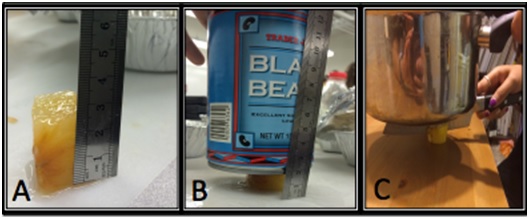
After the apples are baked, their lengths (A) and deformations (B) are measured to obtain the elastic modulus. (C) The Puncture Force Test measures the force required to cut through the cooked apples.

Before baking, the Fuji apple had the highest elastic modulus of 170,000 N/m2 and the Pink Lady had the lowest elastic modulus of 130,000 N/m2. After baking, the Granny Smith had the highest elastic modulus of 32,000 N/m2 and the Fuji had the second highest elastic modulus at 28,000 N/m2.
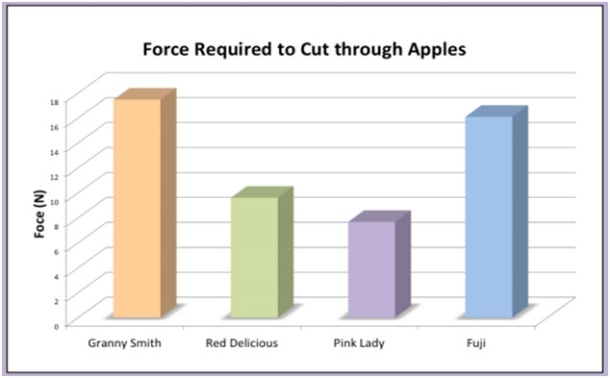
In the Puncture Force Test, the baked Granny Smith apple required the highest puncture force of 18N.
Team Apple Queens found that the cooked Granny Smith apples exhibited the highest elastic modulus and also required the greatest force to cut through. Thus, the Granny Smiths were most resistant to external pressure and remained the crunchiest after baking. Having both the second highest elastic modulus and the second greatest puncture force were the Fuji apples. Based on these results, the team hypothesized that Granny Smith and Fuji apple varieties may contain more of the polysaccharide pectinto fortify their cell walls and make them harder, crunchier apples.
Recipe
Crumbalicious Apple Pie
For the crust:
1 1/3 cup all purpose flour
1⁄2 teaspoon salt
1⁄4 cup (1/2 stick) chilled unsalted butter, cut into 1⁄2-inch cubes
1⁄4 cup frozen solid vegetable shortening, cut into 1⁄2-inch cubes
3 tablespoons (or more) ice water
1⁄2 teaspoon apple cider vinegar
For the filling:
3 Granny Smith apples, peeled, cored, and sliced 1⁄4 inch thick
1 Fuji apple, peeled, cored, and sliced 1⁄4 inch thick
2/3 cup cane sugar
2 tablespoons all purpose flour
2 teaspoons ground cinnamon
2 tablespoons unsalted butter, melted
For the topping:
1 cup all purpose flour
1⁄2 cup cane sugar
1⁄4 cup brown sugar
1 and 1⁄2 teaspoons ground cinnamon
1⁄2 teaspoon salt
6 tablespoons chilled unsalted butter, cut into 1⁄2-inch cubes
Position a rack in the center of the oven and preheat to 375°F.
To prepare the crust:
In a large bowl, mix flour, salt, and sugar. Add butter and shortening; rub in with fingertips until coarse meal forms. We want to incorporate flattened sheets of butter into the flour mixture to get a flaky crust.
In a small bowl, mix three tablespoons of ice water and vinegar. Drizzle the water and vinegar solution over flour mixture. Stir with fork until moist clumps form, adding more water by teaspoonfuls if dough is dry.
Gather dough into ball; flatten into disk. Wrap in plastic and refrigerate for at least 30 minutes. Refrigeration is important for allowing gluten strands to relax (so the dough becomes easier to roll out), and for letting letting liquids incorporate to moisturize the dough.
Roll out dough on lightly floured surface to 12-inch round. (About 1/8th 9-inch-diameter glass pie dish.) Trim overhang to 1/2 inch; turn edge under and crimp decoratively.
Refrigerate while preparing filling and topping.
To prepare the filling:
Mix all ingredients in a large bowl to coat apples.
To prepare the crumble topping:
Blend all ingredients until mixture resembles wet sand.
To assemble the pie:
Toss the filling to redistribute juices and then transfer to crust, mounding in center. Pack topping over and around apples. Bake pie on baking sheet until topping is golden, about 1 hour (cover top with foil if browning happens too quickly). Cool until warm, about 1 hour.
Recipe adapted from Bon Appétit: Cinnamon Crumble Apple Pie
 About the author: Eunice Liu is studying Neuroscience and Linguistics at UCLA. She attributes her love of food science to an obsession with watching bread rise in the oven.
About the author: Eunice Liu is studying Neuroscience and Linguistics at UCLA. She attributes her love of food science to an obsession with watching bread rise in the oven.
The Science of Pie – June 1, 2014
Honorable Mention Pie
Alexis Cary & Matthew Copperman (Team On the Road)
If you’ve baked an apple pie, you have probably encountered the dreaded problem of a soggy pie crust.
The student scientists of Team On the Road sought to solve this pie-baking mishap by determining the optimal apple slice thickness; the idea was that apple slices of varying thickness would release different amounts of water when baked, with more water released giving rise to a soggy crust. To investigate the effect of apple slice thickness, they cooked apples of different slice geometries, and measured the “elastic modulus”, which is how much the apple pieces deform in response to a given applied mass.

(A) Copperman rolls out the pie crust while Cary prepares ingredients. (B) The team presents their pie and poster at the 2014 Science of Pie event. (C) The team tested the elastic modulus of apple slices of varying thicknesses. Photos (A) and (B) courtesy of Patrick Tran. Photo (C) courtesy of Team On the Road.
The team prepared five different samples of apple slices with thicknesses: 3mm, 6mm, 9mm, 12mm, and 15mm. The apples of each thickness group were recorded for mass and elastic modulus before and after being baked for 20 minutes at 375°F.
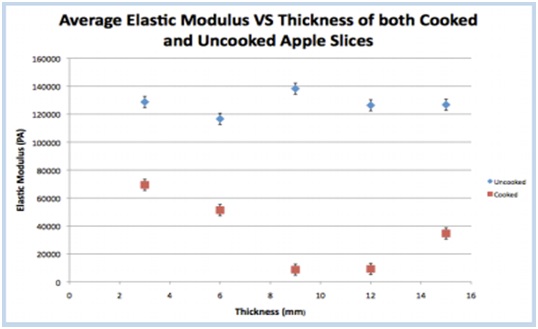
The elastic modulus is shown as a function of slice thickness for uncooked (blue) and cooked (red) apples.
The thinnest apple slices (3mm) had the least change in elastic modulus. In fact, as the slices increased in thickness, they showed increased deformation in apple shape and texture after cooking. There is an exception for the thickest apple slice (15mm), which the team attributes to the thickest apples not being fully cooked in 20 minutes. Because the thinnest apple slices maintained their firm texture and released the least amount of water, Team On the Road used extremely thin apple slices in their final pie. Soggy pie crusts, begone! Thin apple slices are here to save the day!
Note: While the team cut their slices by hand, we recommend using a mandoline to achieve uniformly thin slices of applies.
Recipe
Perfectly Unsoggy Classic Apple Pie
For the crust:
2 1/2 cups unbleached all-purpose flour, plus extra for dusting
2 tablespoons granulated sugar
1 teaspoon table salt
4 tablespoons cold vegetable shortening, cut into 8 pieces
16 tablespoons cold unsalted butter, cut into 16 pieces
6 – 8 tablespoons ice water
For the filling:
3/4 cup granulated sugar
2 tablespoons all-purpose flour
1 teaspoon lemon zest from 1 medium lemon
1/4 teaspoon table salt
1/4 teaspoon ground nutmeg
1/4 teaspoon ground cinnamon
1/8 teaspoon ground allspice
1 lemon’s worth of lemon juice
2 pounds Granny Smith apples, peeled, cored, and sliced as thin as possible (approx. 1/8” is as small as this team consistently achieved.)
1 pounds Gala apples, peeled, cored, and sliced the same as the Granny Smith Apples
For assembly:
1 egg white, beaten lightly
1 tablespoon granulated sugar, for topping
Adjust oven rack to lowest position, place rimmed baking sheet on rack, and heat oven to 400 °F.
To prepare the crust:
Process flour, sugar, and salt together in food processor until combined, about 5 seconds. Scatter shortening over top and pulse mixture for 5 times, 2 seconds each pulse.
Scatter butter over top and pulse mixture until it resembles coarse crumbs, about 10 pulses. Transfer mixture to large bowl.
Add 3 tablespoons ice water over the mixture. Stir and press dough together. (The team used a stiff rubber spatula.) Add 3 more tablespoons of water and mix until dough sticks together. Continue to add remaining ice water, less than 1 tablespoon at a time, as needed until the dough comes together.
Divide dough into two even pieces. Next, it is very helpful to lightly flour counter, hands, and rolling pin. Roll out dough into 12-inch diameter circles and transfer one of the circles into pie pan. Let excess dough hang over the edge. Press dough lightly into the bottom, corners and edges of pan.
Wrap in plastic wrap and refrigerate for at least 1 hour. Wrap the other pie crust dough in plastic wrap and refrigerate. Refrigeration is important for allowing gluten strands to relax (so the dough becomes easier to roll out), and for letting letting liquids incorporate to moisturize the dough.
To prepare filling:
Mix sugar, flour, lemon zest, salt, nutmeg, cinnamon, and allspice together in large bowl. Add lemon juice and apples and toss until combined. Let apples sit in mixture for 5-10 minutes.
To assemble the pie:
Remove pie dough from refrigerator.
Pour apples into the dough-lined pie pan, adding about half of the liquid from the apple mixture to the pie pan. Spread apples so that they create a slight mound in the middle.
Loosely roll remaining dough round around rolling pin and gently unroll it onto filling. Trim overhang to 1/2 inch beyond lip of pie plate. Pinch edges of top and bottom crusts firmly together, pressing overhanging dough towards the pie pan until it lies flush with the pan.
Crimp dough evenly around edge of pie using your fingers. Cut a 2-inch “X” into the upper crust. Brush surface with beaten egg white and sprinkle evenly with remaining 1 tablespoon sugar.
Place pie on heated baking sheet, and bake for 30 minutes. Rotate pie and bake for an additional 30 minutes. Crust should be golden brown. If necessary cook for up to 10 minutes longer.
Let pie cool on wire rack. Serve at room temperature.
 About the author: Eunice Liu is studying Neuroscience and Linguistics at UCLA. She attributes her love of food science to an obsession with watching bread rise in the oven.
About the author: Eunice Liu is studying Neuroscience and Linguistics at UCLA. She attributes her love of food science to an obsession with watching bread rise in the oven.
Nicole Rucker is a pastry chef for the Gjelina group, more specifically, Gjelina Take Away in Venice. At the beginning of her culinary career, Rucker worked in various bakeries and cafes across California, from San Francisco to San Diego. In the quest to create the perfect pie crust, Rucker came up with a recipe that helped her win the KCRW Annual Good Food Pie Contest in Los Angeles, as well as a blue ribbon in the National Pie Championship in Orlando. Fascinatingly, her award-winning apple pie utilizes dried apples and cardamom.
On your mark…
Get set…
GO!
As the doors swung open, guests eagerly awaiting the final Science & Food lecture series were transported to a place nothing short of a Pie-Palooza. Twenty student teams stood confidently next to their baked confection and explained to the judges how they employed the scientific method to creatively reimagine the art of baking the perfect pie. Some developed aqueous solutions to modify the flakiness of their pie crusts while others sought to improve filling texture by altering pH levels and used techniques such as microscopy to measure their results. Whatever their approach, the students proved that a little bit of science goes a long way in mastering the craft of pie baking.

Dr. Paul Barber (Associate Professor, UCLA) and Dave Arnold carefully evaluate the student pie presentations
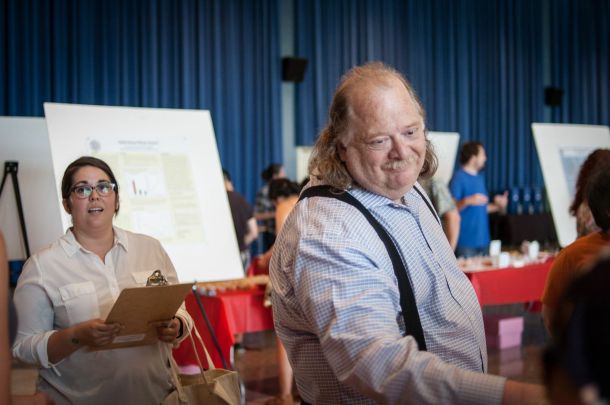
Nicole Rucker (Pastry Chef, Gjelina Take Away) and Jonathan Gold (Food Critic, LA Times) partner up as special guest judges
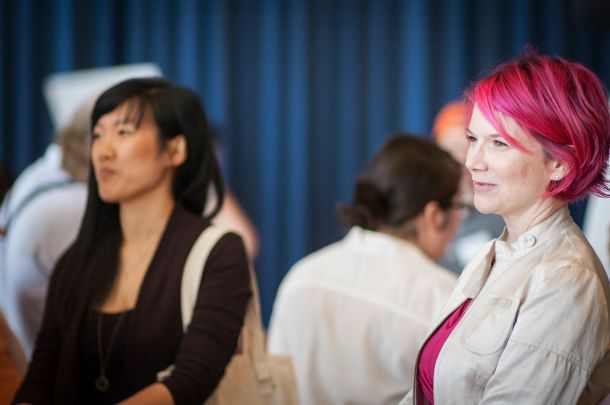
Lena Kwak and Dr. Rachelle Crosbie-Watson (Associate Professor, UCLA) take a closer look at student posters
After the large-scale pie tasting, guest speakers, Lena Kwak and Dave Arnold, took the stage to share their insight on innovation in the culinary laboratory and emphasized how unforeseen mishaps often lead to novel discoveries. Co-Founder and President of Cup4Cup, Kwak discussed how her breakthrough formulation of gluten-free flour was a by-product of her fearlessness to try new techniques and make mistakes in the kitchen. Founder of the Museum of Food and Drink (MOFAD) and Owner of Booker & Dax, Arnold described how curiosity and relentless dedication to experimentation led to the development of many of his out-of-the-box culinary gadgets. Case in point: the Searzall, one of his latest inventions designed for hand-held blowtorches to evenly apply high temperature heat to sear foods while avoiding the remnants of unpleasant aromatics. He also invoked the audience to participate in an experiment where he challenged everyone to digest gymnemic acid, which dulls our sensory perception of sweetness. This exercise was designed to help guests unlock and appreciate the other factors (such as texture) that contribute to our understanding of taste.
Finally, the panel of special guest judges shared with the audience their favorite pies from the student entries and awarded the students with prizes for the “Most Creative Pie”, “Most Qualified to Enter a Real Pie Contest”, “Best Scientific Pie”, “The People’s Choice Pie”, and “Best Overall Pie”.

Tom Folker and Eric Hirshfield-Yamanishi take home the “Most Qualified to Enter a Real Pie Contest” prize
Folker and Hirshfield-Yamanishi explored the effect alcohol, specifically Fireball whiskey, had on the overall flakiness of their pie crust and produced a pie the judges thought was worthy of a professional pie contest.
These creative young women, Lim and So, took the competition to the next level by presenting a deconstructed, rosemary-infused apple pie topped with a “reverse spherified” lemon zest cream cheese sauce to a create a harmoniously balanced and flavorful treat.

Christina Chung, Tori Schmitt, and Elliot Cheung impressed the judges and won the “Best Scientific Pie” award
Chung, Schmitt, and Cheung added different combinations of liquids to generate their pie crust and recorded the amount of force required to alter the elasticity of the baked crust. Ultimately, the incorporation of beer into their pie crust recipe significantly altered texture as measured and quantified by the elastic modulus.
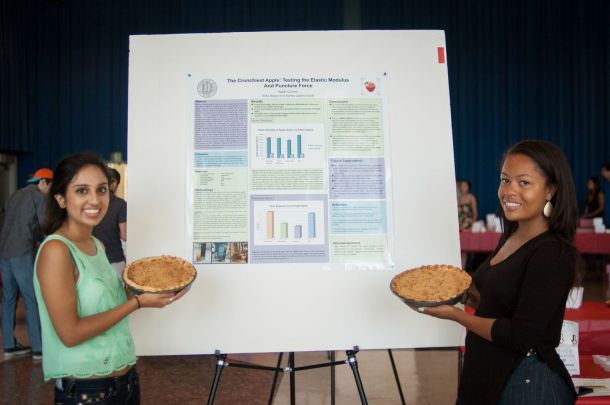
Apple Queens, Alina Naqvi and Ashley Upkins-Scott, stole the show and won both “The People’s Choice Pie” and “Best Overall Pie” prize
Naqvi and Upkins-Scott of team Apple Queens took different varieties of apples, including Granny Smith, Red Delicious, Pink Lady, and Fiji, to produce a crumble top pie that garnered praise from both the audience and the judges.
Congratulations to all the winners!
All photos were captured by Patrick Tran. For more images from the event, visit this photo album.
 About the author: Anthony Martin received his Ph.D. in Genetic, Cellular and Molecular Biology at USC and is self-publishing a cookbook of his favorite Filipino dishes.
About the author: Anthony Martin received his Ph.D. in Genetic, Cellular and Molecular Biology at USC and is self-publishing a cookbook of his favorite Filipino dishes.
A graduate of Rhode Island’s Johnson & Wales Culinary Institute, Cup4Cup President and Co-Founder Lena Kwak began her culinary career as a private chef and caterer. While serving as Research & Development Chef for The French Laundry, Kwak was tasked with testing edible innovations. She excelled quickly and was assigned to devise a gluten-free version of Chef Thomas Keller’s famed Salmon Cornet. The result, which garnered a tearful response from a dinner guest with gluten intolerance, was the genesis of “Cup4Cup.” Since Cup4Cup’s release in 2011, Lena has been honored as one of Forbes’ “30 Under 30” in 2011 and garnered a Zagat “30 Under 30” award in 2012.
See Lena Kwak June 1, 2014 at “Harnessing Creativity (and the Science of Pie)”
Our third and final lecture, Harnessing Creativity (and the Science of Pie), is coming up fast! At the event, students from the Science & Food undergraduate course will be serving up science and apple pies. To get ready, here are 5 fun facts related to apples:
 About the author: Liz Roth-Johnson is a Ph.D. candidate in Molecular Biology at UCLA. If she’s not in the lab, you can usually find her experimenting in the kitchen.
About the author: Liz Roth-Johnson is a Ph.D. candidate in Molecular Biology at UCLA. If she’s not in the lab, you can usually find her experimenting in the kitchen.
Tomorrow is Pi Day, so here are a few fun videos to help you celebrate the most mathematically mouthwatering day of the year. Happy Pi(e) Day! Read more
